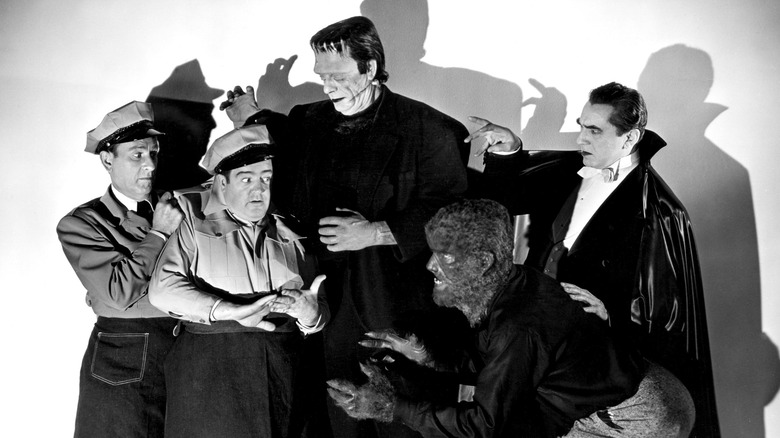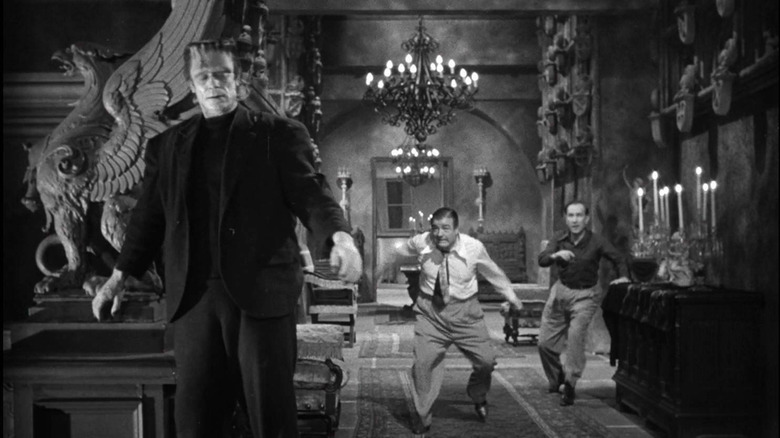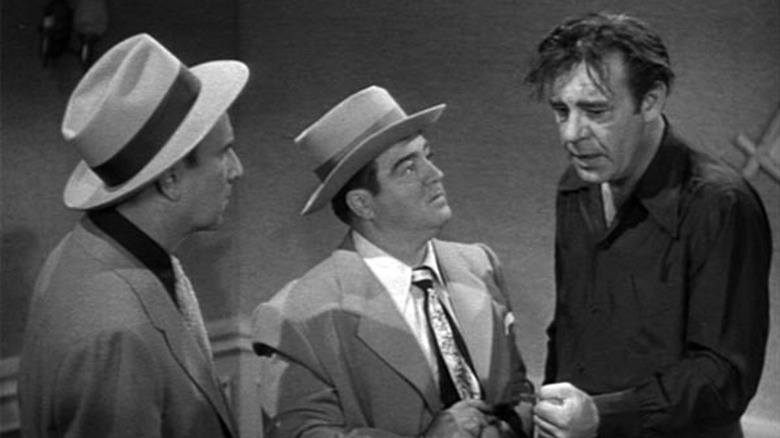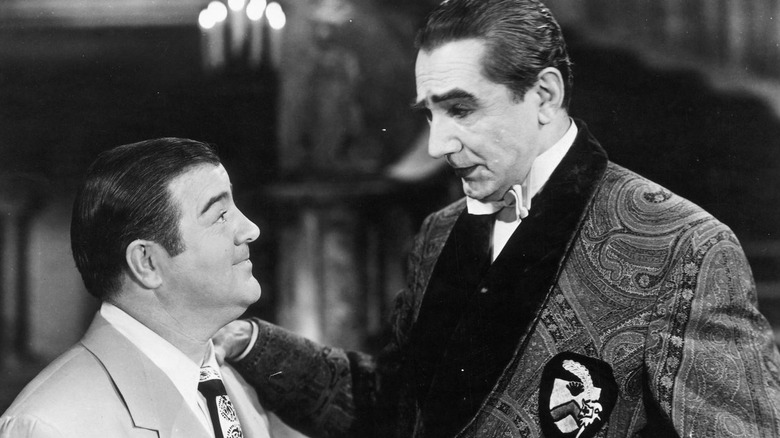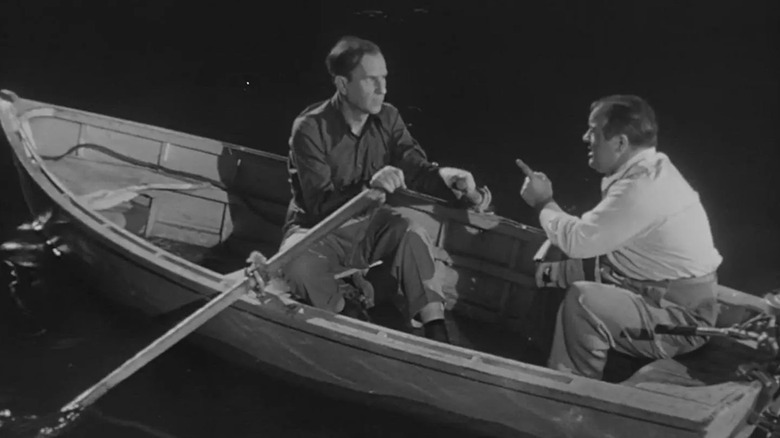Abbott And Costello Meet Frankenstein Is The Best Horror Comedy Of All Time
In the glory days of Universal Pictures, the studio had two big things going for it at the box office: the Universal Monsters, and a comedy duo known as Abbott and Costello. Bud Abbott and Lou Costello met on the burlesque circuit — the story goes that one day, Costello's regular comedy partner got sick, allowing Abbott to step in and begin a long, prosperous partnership. Abbott, tall and thin, was the straight man; a surly, frowning bully who frequently had it up to here with his sidekick. Costello, short and stout, was the fool; the childlike clown who was prone to falling down and acting like a buffoon, all to Abbott's annoyance. The act worked like gangbusters, with the duo moving on to radio before landing a movie contract in 1940. By 1942, they were considered to be the top box office stars in the country.
As for the Universal Monsters, they crept onto the silver screen in 1931 with "Dracula." At the time, a stage production of Bram Stoker's famous vampire novel was drawing in audiences, and Carl Laemmle, Jr., son of Universal founder Carl Laemmle, saw box office gold. The studio plunked down $40,000 (about $779,397 today) for the rights, and Bela Lugosi, who played the Count on the stage, slipped into the cape once again. "Dracula" ended up being a smash hit for the studio, and, just like movie studios of today, Universal saw franchise potential. "Frankenstein," "The Bride of Frankenstein," "The Mummy," "The Wolfman," and many more, would follow.
But what goes up must come down. In the mid-40s, Abbott and Costello's popularity began to wane. They were no longer getting along and considered splitting up. As for the Universal Monsters, they were still flooding the screen, but the quality had dropped considerably, producing not-so-great titles like "The Mad Ghoul" and "She-Wolf of London." And then something clicked. Writer and producer Robert Arthur and frequent Abbott and Costello collaborators Frederic Rinaldo and Robert Lees struck on a potentially brilliant idea: what if two of Universal's most popular franchises teamed up in one film?
This is the story of how "Abbott and Costello Meet Frankenstein" rescued Abbott and Costello's careers, resurrected the Universal Monsters, saved Universal Pictures, and became the best horror-comedy of all time.
The Brain of Frankenstein
Success was not a foregone conclusion. By all accounts, Lou Costello was not a fan of the idea — initially titled "The Brain of Frankenstein." "You don't think I'll do that crap do you?" the comedian asked after reading the screenplay. "My 5-year-old daughter can write something better than that." Costello came around to the idea eventually — thanks to a financial incentive (he was offered a $50,000 advance on his percentage, about $614,462 in today's dollars). Of course, that didn't guarantee a smooth set. Director Charles Barton claimed Abbott and Costello were hell to work with, often not even showing up for scenes. Sometimes they'd even leave in the middle of shooting to go play cards.
But here's the thing: none of that animosity shows on the screen. Instead, we're blessed with the best horror comedy of all time. Horror comedy is a tricky genre, and these days, filmmakers tend to fail more than they succeed. The secret to success is to honor both the comedy and the horror, but more often than not, filmmakers will lean heavily into the comedy angle and forget the horror. That's not to say "Abbott and Costello Meet Frankenstein" is some exercise in total, unrelenting terror — but it's firmly rooted in the horror genre. It fits right in with the world of Universal Monsters, while also having genuinely funny jokes.
As the film begins, we meet Chick Young (Abbott) and Wilbur Grey (Costello), baggage clerks working out of the scariest place on earth — Florida. (See? This movie is terrifying already.) Chick is characteristically mean to Wilbur, while Wilbur is a lovable dope. To make things extra baffling, the short, pudgy, childish Wilbur has caught the eye of the beautiful Sandra (an alluring Lenore Aubert), who claims she's attracted to Wilbur for his brain. She's being literal: Sandra is in league with none other than Count Dracula (Bela Lugosi), and the two have cooked up a plan to put Wilbur's childish, pliable brain into the hulking body of the Frankenstein Monster (towering Western player Glenn Strange).
The monsters enter the picture in the unlikeliest of ways: McDougal (grumpy character actor Frank Ferguson), a wax museum owner, has come into possession of the remains of Dracula and Frankenstein's Monster. To be clear: McDougal doesn't say he's come into possession of wax figures of the monsters. He's somehow bought the monsters themselves. I guess there's a black market for Draculas. Of course, Chick and Wilbur are tasked with transporting the boxes containing the supposedly dead monsters to the wax museum house of horrors. And wouldn't ya know it, they have to do so at night in the dark, unable to find the light switch.
I saw what I saw when I saw it!
Sure enough, both Dracula and Frankenstein (we're just going to call him Frankenstein, okay? Let's accept that now) awake from their slumber, although only Wilbur sees this (leading to one of the funniest scenes in the film, where the undead Frankenstein takes one look at the harmless Wilbur and cowers in fear). No one believes Wilbur — at least at first. But there's someone out there who knows the truth: Lawrence Talbot, aka The Wolf Man, played by Lon Chaney Jr.
Chaney Jr. is the glue that really holds "Abbott and Costello Meet Frankenstein" together because the actor plays his role 100% straight and deadly serious. While increasingly goofy things happen around him, Chaney Jr.'s Talbot is a tortured man. He hates being the Wolf Man, and even more than that, he hates Dracula and wants to stop him. Chaney Jr., who had drinking and substance abuse problems at the time (he was hospitalized after taking an overdose of sleeping pills not long after shooting the film) looks suitably tormented here, his face pale, his hair always a mess, his fear of turning into a lycanthrope palpable. We pity him and wish he could control his inner beast. But he can't. Sooner or later, the wolf is going to come out.
In the midst of all this, a gorgeous insurance investigator named Joan (Jane Randolph) is hired by McDougal to find out what happened to his attractions (you know, the dead monsters he bought somewhere). The belief is that Chick and Wilbur stole them, so Joan infiltrates the duo's life and clamps on to Wilbur, making it appear that Wilbur has not one but two beautiful dames lusting after him. Chick is understandably confused and wants Wilbur to share. "I've always shared with you," he matter-of-factly tells Wilbur, as if asking to share a girl is a common thing.
"That's right," Wilbur replies, launching into a classic Abbott and Costello back-and-forth bit. Chick adds: "If I had two cigarettes, I'd give you one." "That's right." "And if I had two pairs of shoes, I'd give you a pair." "Don't I know it." "And if I have two girls...?" Chick asks, raising his voice at the end so Wilbur will get the hint.
After a pause, Wilbur shoots back: "Why don't you light that cigarette, put on those shoes, and take a walk for yourself?"
Oh you irresistible boy
All of this silliness unfolds against an authentically gothic backdrop. Dracula and Sandra live in a towering, spooky castle (actually a gorgeous model that I wish I had in my house) located on a remote island. Let's just take a moment to marvel at the idea that Dracula is living on an island in Florida, and also there's a gothic castle there, too. The castle is loaded with secret rooms, swinging bookcases, and the biggest scary basement you'll ever see. Time at the castle takes up a big portion of the film, with Chick and Wilbur investigating the rooms trying to get to the bottom of things (well, Chick is just humoring Wilbur).
It's here the pair meet Dracula, in disguise as a man named Dr. Lejos (the opportunity for Dr. Acula was right there, and they whiffed it). Even though Wilbur has already seen Dracula, he doesn't recognize Lejos, probably because the Count has traded his tux and cape for an elegant velvet robe, as one does. This role marked Lugosi's last time playing Dracula on the big screen, and the last time he appeared in a major studio picture (the rest of his career would be spent in cheapie Z-movies helmed by folks like Ed Wood). The story goes that Universal almost didn't cast Lugosi in his most famous role — because they thought he was dead.
Slathered in too much make-up and appearing more than a little tired (Lugosi, like Chaney Jr., had his own share of substance abuse problems), Lugosi nonetheless reminds us why his Dracula became so iconic. Smooth, sexy, and scary, he stalks through the film just as seriously as Chaney Jr.'s Talbot. Dracula is not a source of comedy here — indeed, of the three main monsters, only Frankenstein generates laughs, primarily in how he reacts to Wilbur. Dracula remains a force of unspeakable evil; a malevolent figure willing to kill anyone in his way.
And through it all, the comedy keeps coming. The funniest exchange in the whole movie comes when Wilbur and Chick are once again bickering about girls. Speaking about a previous double date, Wilbur whines "You got the best-looking one." "So what?" Chick shoots back. Wilbur continues: "Yours had teeth!" It's an immediately laugh-out-loud funny thing to say — "Yours had teeth"?! Chick adds, reasonably: "Look, Wilbur, yours had teeth too." Now, here comes the kicker. Wilbur goes on: "Did you see that tooth?" Not just teeth, but tooth — this date had such disastrous chompers that Wilbur zeroed in on one tooth specifically. And he's not kidding, because Chick immediately says, with a touch of genuine sympathy: "Yes I happened to see it." Wilbur finishes the bit: "Mine had so much bridge work, every time I kissed her I had to pay toll."
It's exchanges like this that sell how brilliant Abbott and Costello were at their respective roles. that back-and-forth dialogue comes at rat-a-tat speed, like machine gun fire. And you can sense the history between the two men — they love each other, and they hate each other. Even though Chick spends the bulk of the movie bullying Wilbur, the minute Wilbur ends up in real trouble — kidnapped by Dracula and Sandra — Chick is the first to spring into action to save his buddy. They're all each other has in this world of monsters.
There's nobody to frighten us anymore
The danger mounts, the monsters grow stronger, and a grand finale at the castle commences. After almost having his brain removed in an appropriately spark-filled laboratory, Wilbur is saved at the last minute by Chick and Talbot. Frankenstein rises and proceeds to straight-up toss Sandra out a damn window (that's what you get for trying to steal Lou Costello's brain, lady), and then goes after Chick and Wilbur, who run through the castle in comedic terror. No matter where they go, they aren't safe — one moment has them barricading a door, only for Frankenstein to punch right through it (Glenn Strange missed his mark and actually really punched Costello in the face at this moment; Costello kept the scene going like a pro).
As for Dracula and Talbot, they both meet a suitably tragic end together. Transformed into the Wolf Man, Talbot fights Dracula throughout the castle (the vampire throws a vase of flowers at the Wolf Man at one point because, apparently, Dracula is a big idiot who has no idea how to fight). Hoping to flee, Drac transforms into a bat (via some great animation), only to have the Wolf Man grab his tiny bat body and fall off a balcony into raging waters below. The two probably could survive, but it sure looks like they've fought each other to the death, as all feuding monsters must.
Then there's Frankenstein (who Wilbur amusingly nicknames both "Junior" and "Frankie"), who meets his demise on a firey dock. Assuming they're safe, Chick and Wilbur row away from the island, only to discover another monster — The Invisible Man (voiced by Vincent Price!) has magically shown up to scare them some more. It is an admittedly silly ending, but this an admittedly silly movie.
But the silliness plays perfectly against the black-and-white horror backdrop. One gets the sense that this is a straightforward Universal Monster pic that just happened to be invaded by Abbott and Costello, as if the duo wandered onto the wrong backlot. The formula ended up being such a smashing success. In 1946, Universal was barely turning a profit and started cutting actors from their contracts. In 1948, with the box office glory of "Abbott and Costello Meet Frankenstein" (it was one of the highest-grossing Universal pics that year, ultimately scaring up $3.2 million), the studio was back in business. So were Abbott and Costello. After the popularity of "Frankenstein," Universal began playing the duo against more monsters — "Abbott and Costello Meet the Killer, Boris Karlof," "Abbott and Costello Meet the Invisible Man," "Abbott and Costello Meet Dr. Jekyll and Mr. Hyde," and "Abbott and Costello Meet the Mummy."
None of these films come close to matching "Meet Frankenstein," (although I have a soft spot for "Meet Dr. Jekyll and Mr. Hyde"), because none of the titles seemed to grasp the formula that made "Meet Frankenstein" a success. The movies got progressively goofier, downplaying the monsters for more gags. But "Abbott and Costello Meet Frankenstein" loves its monsters. It lets them roam through moonlit nights, in search of fresh victims. It's the perfect blend of haunt and humor, and no matter how many years go by, it keeps us laughing — and screaming.
